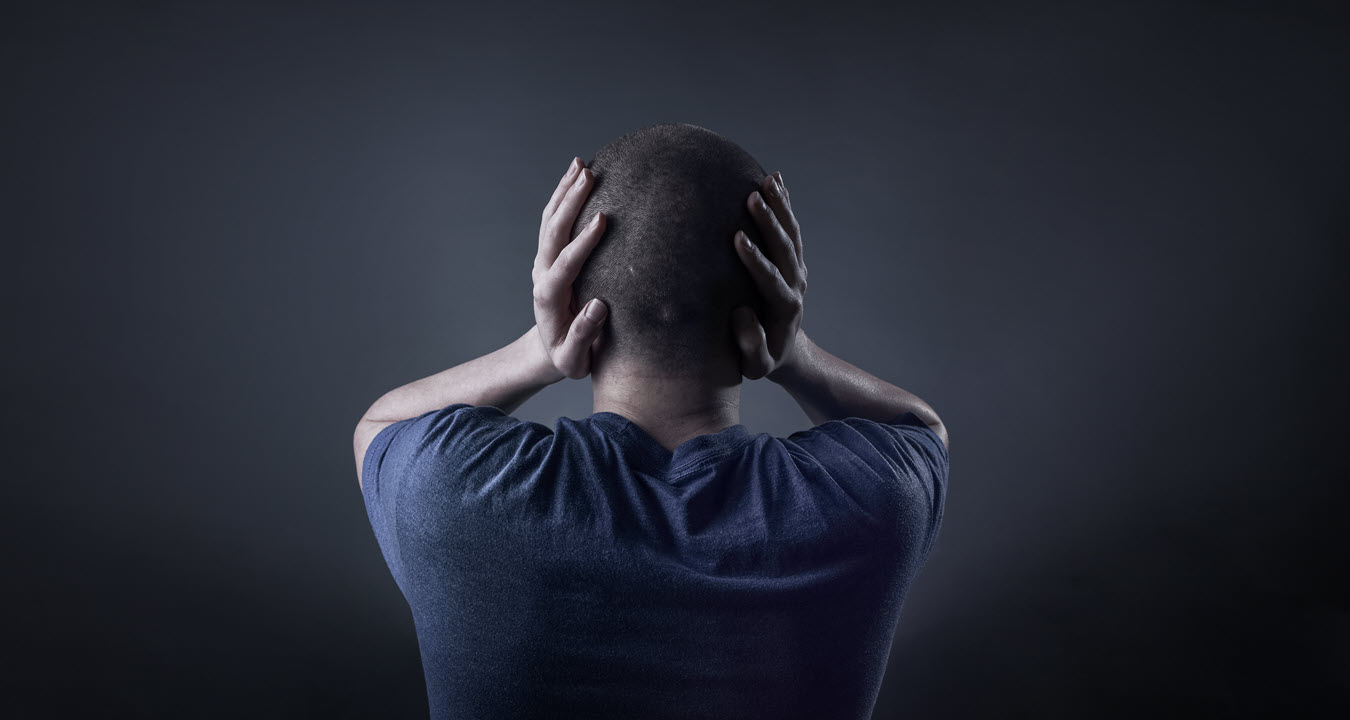 Unpredictable, overpowering, and debilitating…
Unpredictable, overpowering, and debilitating…
That’s what anxiety feels like as it takes over your body and mind. It’s like you’re trapped… powerless against it.
It’s not long before you start saying to yourself, “I must be doing something wrong.”
Cycles of unending criticism, self-judgment, self-loathing and negative self-talk sabotage you further.
Bodily sensations such as trembling, shaking and sweating leave you shamed and embarrassed.
And that produces even MORE anxiety!
 And when the anxiety gets excessive…
And when the anxiety gets excessive…
It’ll turn into depression, phobias, and outright panic attacks.
Sure, you do things to try to release yourself from the pain, like…
… avoiding people, places, or situations…
… doing various rituals to cope…
… pretending that your anxiety and panic will go away on their own….
… or denying there’s anything wrong in the first place.
But nothing releases your pain, and your brain feels like it’s going to explode trying to deal with it!
 Therapy is a great way to get anxiety under control.
Therapy is a great way to get anxiety under control.
Lisa* was an extremely negative thinker.
She hated the cycle of negativity, nervousness, sabotage, and defeat.
We identified how her thinking created more anxiety and limited her lifestyle, and she learned to use CBT to reverse and restructure her thinking patterns. We also incorporated relaxation therapy to give her relief.
Lisa yearned for more positivity in her life and to know that her life was going in the right direction. We focused on building coping skills to minimize avoidant behaviors that led to increased nervousness. She was afraid to reach out to supportive people.
We worked on how to communicate better and not prejudge their opinions. Lisa understood that when she did not reach out, her anxiety grew, and she put up barriers to success. Her ability to build self-compassion and value for herself helped her minimize procrastination, perfectionism, and criticism.
She engaged in savoring life – actually being mindful and enjoying what she was doing in the moment. This gave her motivation and purpose. We set a baseline for her to appreciate what she already has instead of focusing on all she does not. Cultivating optimism – the ability to strive for good things became a strength.
Lisa already had a strong desire to live a better life, was a kind soul, and took gratitude from helping others. Today she is still working on minimizing anxiety, but she is in college, working, and has developed a new network of friends.
 Ellen* went to the ER with…
Ellen* went to the ER with…
… chest pain, dizziness, heart palpitations, and shortness of breath. To her surprise, she had had her first panic attack.
This left her afraid and overwhelmed about when the next one would come.
We explored her frustration in not knowing the source of her attacks.
Ellen was a master at irrational thinking – ruminating, self-deprecating, catastrophizing. This was the source. She forecasted everything, predicting a future event where the worst would happen. Maybe or maybe not? She was feeding her anxiety and cycling into a panic/overthinking pattern.
This led to defeat. The hurtful self-judgment led to more anxious feelings. All or nothing thinking, mind reading, what ifs, and overgeneralizing overwhelmed her.
We used CBT interventions to develop coping skills to challenge negative thinking patterns that led to unhealthy behaviors and avoidance. We wanted her to be able to interpret events in a healthier way.
In therapy, Ellen faced her fears. By confronting those fears head-on, she could desensitize her reactions to what triggered them. We made a list and uncovered what lay beneath … deeply rooted misbeliefs and unrealistic expectations.
She used self-talk to verbalize the thoughts as they came to be and challenge them by looking for evidence they were true. Exploring fear of rejection and the need to control were triggers. She learned to lean into negativity and accept worry as a necessary part of life. This allowed her to sit with the irrationality, observe feelings, and lessen reactions. Writing down her thoughts on paper helped her understand her role in her mental health.
Ellen has started yoga and meditation and can distance herself from her thinking. She still works toward building her coping skills but feels more in control of her life.
 Karen* had OCD rituals that no one understood.
Karen* had OCD rituals that no one understood.
She was teased and misunderstood by everyone around her. This led her to question EVERYTHING. She couldn’t drive at times, was always late, and often struggled to get out of the house.
We worked on identifying what triggered these thoughts and behaviors. It took us a while to understand that at the core of Karen’s OCD was fear of vomiting or being around it… Emetophobia. It panicked her and made her avoidant, all in pursuit of never having this occur. It didn’t matter how it started. She knew it was escalating. Anticipating stopped her from seeing friends. She developed unhealthy eating habits and maintained a poor body image.
We formulated a hierarchy of her OCD rituals. We listed sources of anxiety arranged in order of how severe each fear is and how much distress it causes, numbering each so she could visualize the most fearful vs. lesser stressors. Our goal was to expose her to these situations and allow her to problem solve. We worked at her comfort level to attack the lesser stressors first, allowing her to gain confidence. She understood her compulsions were short-term stress reducers that actually increased her obsessions.
We evaluated her thinking patterns, labeled them, and slowly worked on allowing her to sit with her thoughts in a self-compassionate, nonjudgmental way feeling slight discomfort.
We learned about eating disorders and linked her to a dietician. She felt relieved she could avoid her trigger foods and eat more of what she wanted. A medication evaluation gave her options to balance her life.
Therapy gave Karen many coping skills to cope with her anxiety and build her confidence. She’s now working and going to school.
 Tom’s* social anxiety left him feeling isolated.
Tom’s* social anxiety left him feeling isolated.
Because he avoided social engagements, others categorized him as aloof, unfriendly, and arrogant. And he knew it, which made him even MORE afraid to be with his peers.
He feared being the center of attention.
He hated meeting new people and ran from authoritative figures.
He felt awkward talking to others.
Tom’s anxiety led to a deepening depression. He wasn’t enjoying life at all.
The first thing we did was challenge his negative thinking using CBT.
Overthinking played a big part in his emotional instability. He immediately assumed his thoughts were true because they were there. His main issue was overestimating a social threat… the probability his fears would come true and how bad they would actually be. The higher the threat, the more anxious he became…
I am inept socially.
I always say something wrong.
I will embarrass myself by sweating and shaking.
We identified his triggers. Listing the negative statements allowed us to delve deeply into each one.
Is my thought based upon fact, or am I mind reading?
Am I jumping to conclusions?
Like investigators, we looked at what was true, partially true, and false. Tom was able to look for contrary evidence and consider alternate ways of viewing his situation.
We also conducted “exposure therapy” to make him more comfortable in group settings. We ranked each of his fears numerically so that he had a visual range. He picked the least harmful situation and agreed to face it. We planned an experiment for a safety test. What could he do to find out how accurate his thoughts were? How could we create a situation to test the accuracy of distress? We used charts to track his experiences and talked each through using supportive therapy.
Tom’s first success was interacting with a cashier. Today, Tom can attend events and communicate with others at his comfort level.
 Anxiety is a normal part of life, but…
Anxiety is a normal part of life, but…
If it’s taking over your life or hitting you in waves so intense that you’re developing panic attacks, it’s time to act.
Whether you have anxiety in general, social anxiety, phobias, panic attacks, OCD, or PTSD, I can help.
I take a multifaceted approach to anxiety and panic disorders and use many therapeutic techniques focused on the brain and the body such as CBT, Psychodynamic work, Somatic and Polyvagyl Therapy. We can help you manage your thoughts, feelings, and behaviors to have control, confidence, and trust in yourself.
You CAN get through this and be happy again!
Let’s do this… together. Call today for your free 15-minute consultation: (516) 446-8910.
*Names changed for client confidentiality.

